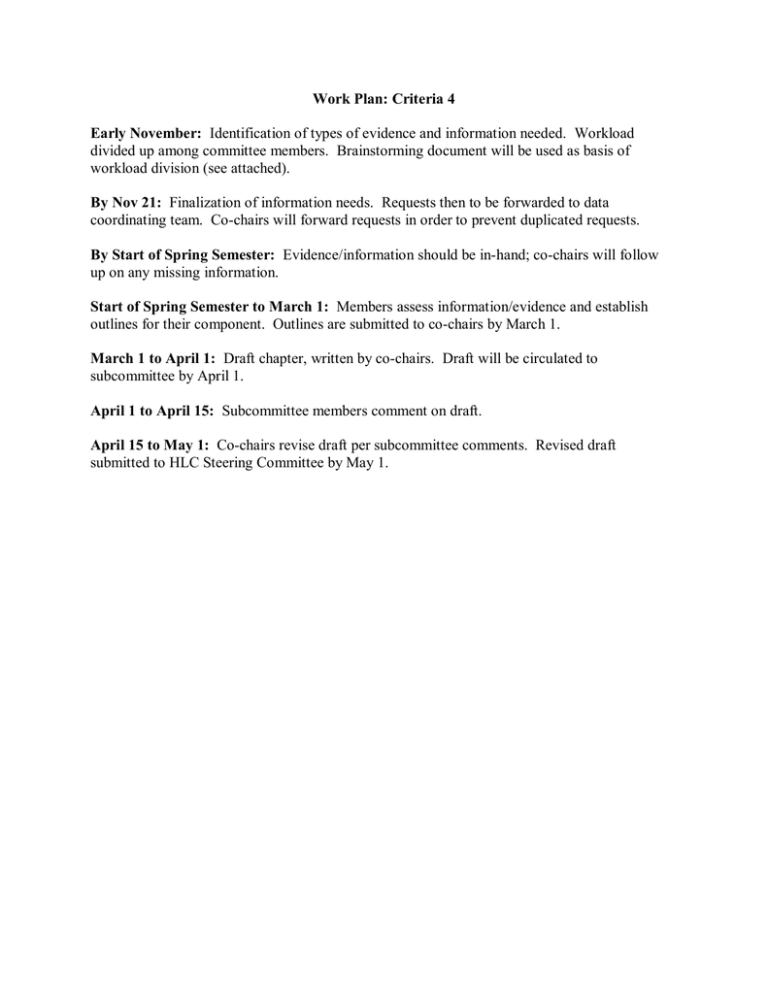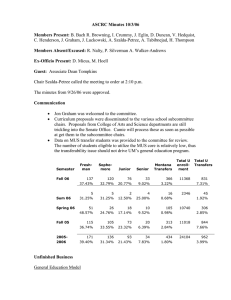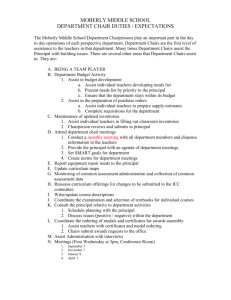Work Plan: Criteria 4 Early November: By Nov 21: By Start of Spring Semester:
advertisement

Work Plan: Criteria 4 Early November: Identification of types of evidence and information needed. Workload divided up among committee members. Brainstorming document will be used as basis of workload division (see attached). By Nov 21: Finalization of information needs. Requests then to be forwarded to data coordinating team. Co­chairs will forward requests in order to prevent duplicated requests. By Start of Spring Semester: Evidence/information should be in­hand; co­chairs will follow up on any missing information. Start of Spring Semester to March 1: Members assess information/evidence and establish outlines for their component. Outlines are submitted to co­chairs by March 1. March 1 to April 1: Draft chapter, written by co­chairs. Draft will be circulated to subcommittee by April 1. April 1 to April 15: Subcommittee members comment on draft. April 15 to May 1: Co­chairs revise draft per subcommittee comments. Revised draft submitted to HLC Steering Committee by May 1. Brainstormed List of Topics for Criterion Four, Chapter 17 1) Faculty Development a) Workshops and other training i) related to learning & teaching · teaching centers ii) related to learning & research b) Travel i) amount of travel by faculty and money spent per person · for conferences · for research · for teaching c) Internal grants or development leaves i) for research · PDA · University research grants · College research grants ii) For teaching · Curriculum development grants d) Academic freedom: university policy and belief e) Awards for teaching and research 2) Infrastructure a) Rod Library resources b) ITS c) UNI Museum d) Arts Collections e) Laboratories at technology support i) Examples by College (e.g. GIS lab) 3) Grants a) OSP structure and function b) Number of grants and $ amounts c) Sources of external funding 4) Research a) University support i) OSP ii) Other support? Colleges? b) Publications i) Amounts (articles, books, chapters, etc.) ii) Outlets of publication (journals, publishers, etc.) iii) Conference participation c) Performances & visual arts i) Performances; types, locations, numbers ii) Exhibitions: types, locations, numbers iii) Galleries: permanent/temporary, types, locations d) Major research programs on campus i) GeoTREE ii) Iowa Center for Immigrant Leadership and Integration iii) Tallgrass Prairie Center iv) Science Center for Teaching, Outreach and Research in Meteorology v) Center for Social and Behavioral Research vi) Price Laboratory School vii) John Pappajohn Entrepreneurial Center viii) others 5) Student Research a) Graduate students i) Enrollments & programs ii) Theses / research­related culminating projects · Numbers · Types; thesis, research papers, curriculum development, community engagement, other… iii) Student publishing / publishing with students iv) Student travel for conferences or research v) Grad student awards; internal & external vi) awards b) Undergraduate students i) Undergraduate research opportunities · Funding · Working with faculty; examples · McNair Scholars projects · Honors Theses · Departmental undergraduate theses or research seminars ii) Student travel for conferences or research iii) awards iv) Study abroad v) Cooperative education vi) Career center c) All students i) Student research conferences · CSBS Student Research Conference · Sigma Xi Student Research Conference 6) The LAC as a Life of Learning opportunity a) Provides breadth of choice, dept of content i) i.e. wide range of selection within basic categories, but not all “watered down” LAC­ specific classes b) Non­western courses; world view c) Capstone courses; integration 7) Global Readiness a) LAC b) Study Abroad opportunities c) Student and faculty diversity (sex, race, international) d) Global studies & area studies (?) e) Cooperative education f) Career center 8) Responsibility & Integrity a) Training opportunities (?) b) Research Integrity i) Institutional Review Board c) Plagiarism and academic integrity policies i) Policies for students and classes (policies & procedures 3.01) ii) Policies for faculty and staff (policies & procedures 6.10) iii) Academic Freedom (policies & procedures 13.10) d) Ethics & knowledge i) As related to students education (?) 9) Leadership Training a) For Faculty i) Administrative Fellow ii) Leadership Task Force: UNI Culture & Recognizing Leadership Initiatives Subcommittee b) For Students i) Leadership Studies Program (CoE) 10) Lifelong Learning for Non­Teaching Staff a) Employee scholarships/tuition (do we have any?) b) Workshops & training i) MEMFIS Users Group ii) Human Resource Services · Staff Training Grant Program · Self­Paced online learning · Allen Employee Assistance Program iii) SOAR: UNI performance improvement initiative for managers and supervisors 11) Assessment of the Acquisition, Discovery, and Application of Knowledge a) Program assessment procedures b) Advisory boards c) Certification programs & exams Criterion Four components. Above outline should ultimately be formulated under these sections. 4a The organization demonstrates, through the actions of its board, administrators, students, faculty, and staff, that it values a life of learning. 4b The organization demonstrates that acquisition of a breadth of knowledge and skills and the exercise of intellectual inquiry are integral to its educational programs. 4c The organization assesses the usefulness of its curricula to students who will live and work in a global, diverse, and technological society. 4d The organization provides support to ensure that faculty, students, and staff acquire, discover, and apply knowledge responsibly.

